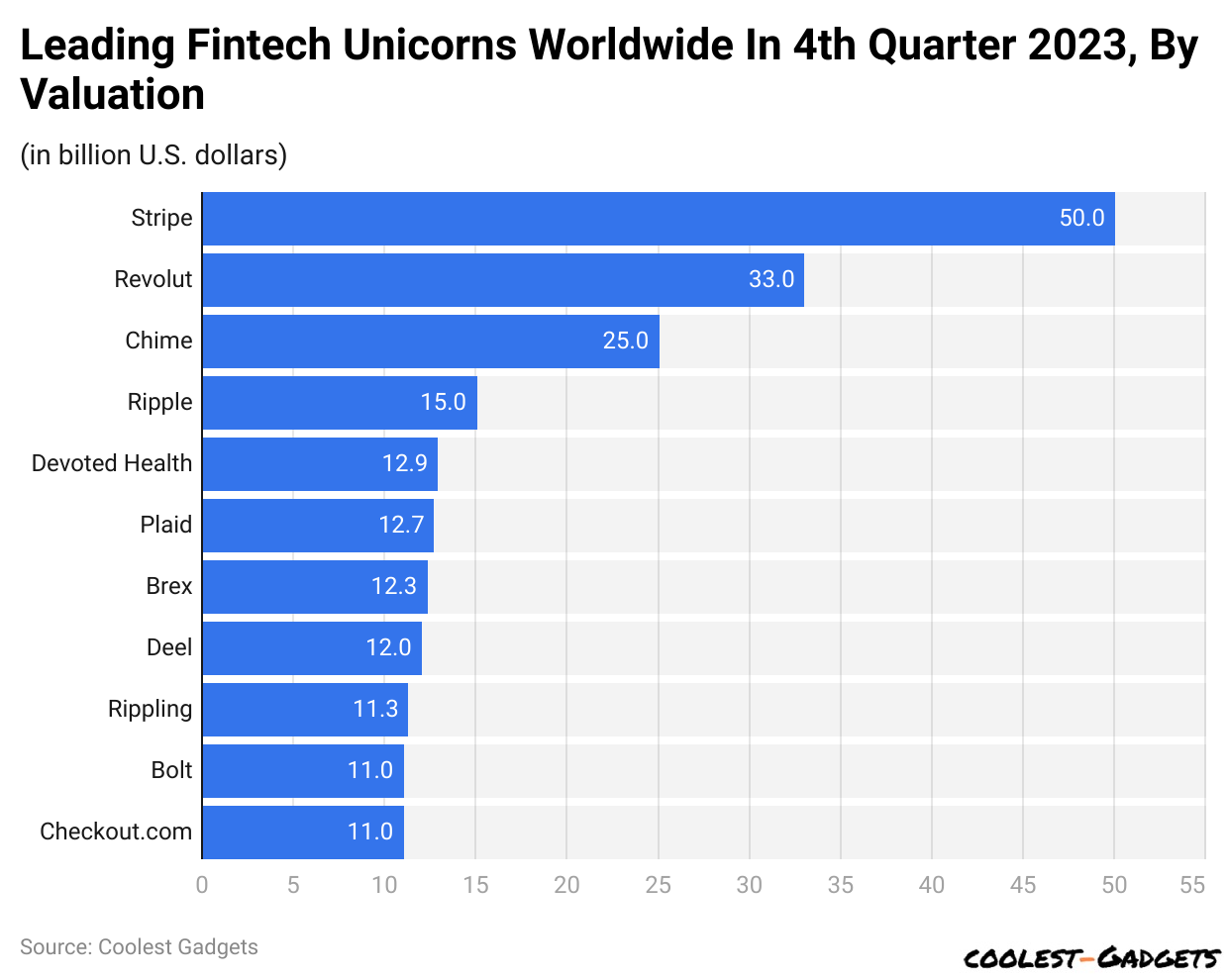FinTech Statistics 2024 By Top Companies and Market Size

WHAT WE HAVE ON THIS PAGE
Introduction
FinTech Statistics: Fintech, or financial technology, is transforming the world from traditional financial methods to digital ones. This technology makes financial services accessible to everyone and makes them easier and faster. In simple language, sending money to a friend or family member using a mobile app is a Fintech.
Furthermore, online banking is also part of Fintech. Since COVID-19, the world has primarily changed its focus to online activities, and the Fintech industry has benefited the most. In short, the FinTech industry is an innovation that allows the world to accept its digital existence. Let’s understand the FinTech Statistics of 2024.
Editor’s Choice
- 49% of banks and 60% of credit unions in the USA believe that Fintech partnerships play an important role.
- According to FinTech Statistics, 40.5% of investment deals in the sector were made by the United States of America in 2023, being the highest. It was followed by Europe and Asia with 23.75% and 20.5% respectively.
- Chatbot-based customer interactions are estimated to capture 95% of the total market in the next ten years.
- Digital assets are estimated to be the largest assets in 2024, with an AUM of $80.08 billion in the worldwide market.
- According to a report by Brimco, 82% of financial companies are planning to increase FinTech partnerships within the next 3 to 5 years.
- 96% of consumers around the world know at least one alternative to a Fintech-based company or service.
- In Q4 of 2023, Stripe was the most valuable FinTech Unicorn globally, with a market valuation of $50 billion.
- Currently, the largest fintech product is digital payment, with 25% of all captured markets.
- Chime was the most used Neo Banking app in 2023, compared to other brands by popularity and usage among Americans.
- Around 88% of insurers, investment managers, and banks are worried about losing revenue to Fintech firms if they do not adapt to the technology awareness.
General FinTech Statistics
- According to FinTech Statistics, 40.5% of investment deals in the sector were made by the United States of America in 2023, being the highest. It was followed by Europe and Asia with 23.75% and 20.5% respectively.
- Compared to 2022, in 2023, the worldwide FinTech average and median deal size fell to $13.8 million, which was $16.8 million in the previous year.
- Currently, the largest fintech product is digital payment, with 25% of all captured markets.
- 49% of banks and 60% of credit unions in the USA believe that Fintech partnerships play an important role.
- FinTech Statistics estimate that, by 2025, digital peer-to-peer lending will reach more than $2.5 trillion.
- 96% of consumers around the world know at least one alternative to a Fintech-based company or service.
- Chatbot-based customer interactions are estimated to capture 95% of the total market in the next ten years.
- Around 88% of insurers, investment managers, and banks are worried about losing revenue to Fintech firms if they do not adapt to the technology.
- According to a report by Brimco, 82% of financial companies are planning to increase FinTech partnerships within the next 3 to 5 years.
- FinTech Statistics estimates that the number of mobile banking users will reach more than 4 billion by 2026
- Furthermore, the worldwide InsurTech market is estimated to reach $10.14 billion by 2025.
- In 2024, the success rate of Fintech startups is around 25%.
- As of 2023, there are around 26,300 Fintech startups around the world.
FinTech Market Size By Region
Worldwide
- Digital assets are estimated to be the largest assets in 2024, with an AUM of $80.08 billion in the worldwide market.
- Furthermore, the average AUM per user in a similar segment is projected to amount to $96.05 in the current year.
- On the other hand, the total market AUM is estimated to be valued at $80.08 billion in 2024.
- In the global FinTech Industry, the digital assets market is estimated to generate revenue growth of $17.38%.
- FinTech Statistics estimate that by 2028, the total number of users in the worldwide market in a similar segment is expected to reach 4,805.00 million.
Asia
- The total AUM in the Asian digital assets market is estimated to amount to $12.15 billion in 2024.
- The total number of users is estimated to reach 2,961.00 million by 2028.
- In 2024, the AUM per user is projected to amount to $27.71.
- Similar to the worldwide market, digital assets are projected to be the largest market in Asia, with an AUM of $12.15 billion in the current year.
- By 2025, the FinTech market by digital assets is projected to generate a revenue growth of 16%.
Africa
- The total AUM in the African digital assets market is estimated to reach $704.10 million in 2024.
- On the other hand, the average per user in a similar segment is estimated to amount to $16.37 in the current year.
- By 2028, the total number of users is projected to reach 357.00 million.
- In addition, by 2025, the digital asset market is expected to generate revenue growth of 20.03%.
Americas
- As of the current year, the largest market is projected to be Digital Assets, with an AUM of $44.42 billion.
- By 2025, the digital assets market is projected to generate a revenue growth of 18.18%.
- The total number of users is estimated to reach 777.00 million by 2028.
- In 2024, the average AUM per user in a similar segment is projected to be $249.40.
- On the other hand, the total AUM in the American digital assets market is estimated to be valued at $44.42 billion in 2024.
Australia And Oceania
- Digital assets are estimated to be the largest segment in the Australian and Oceania markets, with an AUM of $1,933.00 million in the current year.
- The total number of users is expected to reach 35.43 million by 2028.
- By 2025, the market is estimated to generate a revenue growth of 17.84%.
- The average AUM per user is expected to amount to $224.30 in 2024.
Europe
- By 2025, the digital assets market in Europe will show a revenue growth of 16.35%.
- Furthermore, in 2024, the largest market is projected to be Digital Assets, with an AUM of $20.87 billion.
- In 2024, the total AUM in the market is estimated to be $20.87 billion.
- The total number of users is projected to be 674.60 million.
- The average AUM per user is estimated to amount to $126.10 in 2024.
Leading FinTech Unicorns Worldwide By Valuation
 (Reference: statista.com)
(Reference: statista.com)
FinTech Statistics 2023 show that, in Q4 of the mentioned year, Stripe was the most valuable FinTech Unicorn globally, with a market valuation of $50 billion. Revolut and Chime ranked respectively with $33 billion and $25 billion in valuation, which Ripple and Devoted Health further followed.
Neobanking And Neo Brokerage Awareness In The USA By Brand
(Reference: statista.com)
Chime was the most used Neobanking app in 2023, compared to other brands, in terms of awareness, popularity, and usage among Americans. Other leading brands were SoFi, E-Trade, Robinhood, Acorns, and Dave.
Market Capitalization Of The Biggest FinTech Companies Worldwide
According to FinTech Statistics 2024, the following are the largest FinTech companies worldwide, with valuations in billions of dollars.
| Brand Name | Location | Valuation (in billion dollars) |
| Visa | USA | 520.33 |
| Mastercard | USA | 395.64 |
| Intuit | USA | 169.01 |
| Tencent | China | 146.06 |
| Fiserv | USA | 79.87 |
| Ant Financial | China | 78.5 |
| PayPal | USA | 66.26 |
| Stripe | Ireland | 50 |
| Square | USA | 44.35 |
| Nubank | Brazil | 41.5 |
| Adyen | Netherlands | 39.18 |
| Coinbase | USA | 37.53 |
| Chime | USA | 25 |
| Polygon | India | 20 |
| Revolut | United Kingdom | 18 |
| Ripple | United Kingdom | 15 |
| Affirm | USA | 14.06 |
| Blockchain | Luxembourg | 14 |
| UIPath | Romania | 13.47 |
| Plaid | USA | 13.4 |
(Source: statista.com)
Top 10 Largest Fintech Companies By Expense Ratio
According to a report by Forbes Advisor 2024, the following are the top 10 largest Fintech-based companies.
- Ant Group – $78.5 billion
- Stripe, Inc. – $50 billion
- Revolut – $33 billion
- Chime Financial, Inc – $25 billion
- Rapyd – $15 billion
- Plaid – $13.4 billion
- Brex, Inc.- $12.3 billion
- GoodLeap – $12 billion
- Bolt – $11 billion
- Checkout.com $11 billion
FinTech: Your Financial Toolkit In The Digital Age
Imagine managing your money with the same ease you use your phone. That’s the promise of FinTech, a booming industry that combines “finance” and “technology” to revolutionise how we handle our money. Forget bulky chequebooks and long bank lines; FinTech offers a suite of user-friendly tools for everyone.
FinTech 101: Making Money Management Simple
FinTech companies use technology to create user-friendly tools for managing your finances. Here are some real-life examples you might already be familiar with:
- Mobile Banking Apps allow you to check your balance, transfer money, and pay bills all on the go. There is no more waiting in lines or worrying about paper statements.
- Payment Apps: Splitting a restaurant bill with friends or sending money back home? Forget cash or awkward check exchanges. FinTech apps make sending and receiving payments a breeze, often instantly.
- Investment Apps: Have you ever wanted to invest in the stock market but felt intimidated? FinTech investment apps offer user-friendly platforms to buy and sell stocks, sometimes with automated investing options based on your risk tolerance.
FinTech’s Diverse Landscape: More Than Just Apps
The FinTech industry is a vast ecosystem with various segments catering to different financial needs:
- Lending: Need a loan for a car, a house, or even your dream business venture? FinTech lending platforms offer competitive rates, faster approvals, and a more streamlined process compared to traditional banks.
- Payments: From mobile wallets like Apple Pay and Google Pay to international money transfer services like Wise or Remitly, FinTech companies are making it easier and faster than ever to send and receive money, both domestically and internationally.
- Wealth Management: Robo-advisors, powered by algorithms, can analyze your financial goals and risk tolerance to manage your investments automatically. This can be a great option for those who want a hands-off approach.
- Blockchain: This secure technology underpins cryptocurrencies like Bitcoin and is finding new applications in FinTech, such as fraud prevention and secure transactions.
FinTech’s Positive Impact: Why It Matters
FinTech companies are revolutionizing the financial landscape by:
- Promoting Financial Inclusion: FinTech offers lower fees and easier access to financial products, bringing more people into the financial system who might have been excluded traditionally. This can be particularly impactful in developing countries.
- Boosting Convenience: FinTech apps make managing your finances a breeze. No more waiting in lines, filling out endless paperwork, or deciphering complex financial jargon.
- Enhancing Competition: With more players in the game, traditional financial institutions are forced to innovate and offer better deals and services to compete with FinTech companies. This ultimately benefits consumers with lower fees and more options.
FinTech 2024 And Beyond A Glimpse Into The Future
The FinTech industry is constantly evolving, and here are some exciting trends to watch out for in 2024 and beyond:
- The Rise of AI: Artificial intelligence (AI) will play a bigger role. AI-powered chatbots will offer personalized financial advice, while AI-powered fraud detection systems will become even more sophisticated, keeping your money safe.
- Open Banking Takes Center Stage: Open banking allows customers to securely share their financial data with third-party apps, allowing for even more customized financial products and services tailored to their unique needs.
Security Remains a Top Priority: As FinTech continues to grow, ensuring the security of sensitive financial data will be a top priority. Companies will invest heavily in robust security measures to protect your hard-earned money.
AI: The Engine Powering The Future Of FinTech
AI has the potential to revolutionize FinTech in several ways:
- Next-Level Robo-advisors: Imagine AI-powered advisors that not only manage your investments but also understand your life goals and automatically adjust your investment strategy based on your evolving needs.
- Smarter Fraud Detection: AI can analyze vast amounts of financial data in real-time to identify and prevent fraudulent transactions before they happen, adding a layer of security to your finances.
- Personalized Financial Experiences: AI can personalize your entire banking experience. Imagine receiving tailored recommendations for savings plans, credit cards, and other financial products based on your unique financial situation and goals.
The Global FinTech Landscape: A Flourishing Ecosystem
The FinTech industry is booming worldwide, but its growth varies by region. Developed countries like the US, UK, and China have well-established FinTech ecosystems with a wider variety of services. Emerging economies are catching up rapidly, with FinTech playing a crucial role in driving financial inclusion. Here’s a quick snapshot:
- North America: Home to established giants like PayPal and Stripe, North America continues to be a leader in FinTech innovation, particularly in areas like mobile payments and wealth management.
- Europe: Europe has a strong FinTech presence with a focus on regulations and security. Open banking is a major trend here, allowing for more collaboration between traditional banks and FinTech companies.
- Asia: Asia is a hotbed for FinTech growth, with China leading the charge. Mobile payments are widely adopted, and digital lending platforms are flourishing.
- Africa: FinTech is playing a critical role in driving financial inclusion in Africa, where a large portion of the population remains unbanked. Mobile money services are making significant inroads, allowing people to access financial services through their phones.
The Current State Of FinTech: A Mixed Bag
Despite its potential, the FinTech industry has challenges. Here’s a look at the current state:
- Funding Slowdown: While the FinTech market is projected to reach $556.58 billion by 2030, funding for FinTech startups has slowed down in 2023 due to the global economic downturn. However, the long-term outlook remains positive.
- Regulation: As the industry matures, regulations are evolving to ensure consumer protection and financial stability. Balancing innovation with appropriate regulations remains a key challenge.
- Cybersecurity Concerns: With more financial data moving online, cybersecurity remains a major concern. FinTech companies need to invest heavily in robust security measures to protect user data.
The Future Is FinTech
FinTech is transforming the way we manage our money, making it more accessible, convenient, and secure. As AI and other technologies continue to evolve, the future of FinTech is bright.
Whether you’re a seasoned investor or just starting your financial journey, FinTech offers a wealth of tools and services to help you achieve your financial goals. So, embrace the FinTech revolution and unlock the potential for a brighter financial future!
Conclusion
Digitalization is bringing the world closer, and this is true not only for socialisation in online shopping but also in the finance industry. The fintech industry has become extremely convenient, as shown by Fintech Statistics, in a way that we can apply for loans on applications without going to banks and following a long process to approve the loans.
This is just a single-person view. Fintech also allows companies to process payments online, prepare online invoices, and work on accounting software. Because of such services, money saving, tracking the spent money, goals tracking, budgeting, and managing finances has become easy.






